Related Research Articles

A crucifix is a cross with an image of Jesus on it, as distinct from a bare cross. The representation of Jesus himself on the cross is referred to in English as the corpus. The crucifix emphasizes Jesus' sacrifice, including his death by crucifixion, which Christians believe brought about the redemption of mankind. Most crucifixes portray Jesus on a Latin cross, rather than a Tau cross or a Coptic cross.

An icon is a religious work of art, most commonly a painting, in the cultures of the Eastern Orthodox, Oriental Orthodox, and Catholic churches. The most common subjects include Jesus, Mary, saints, and angels. Although especially associated with portrait-style images concentrating on one or two main figures, the term also covers most of the religious images in a variety of artistic media produced by Eastern Christianity, including narrative scenes, usually from the Bible or the lives of saints.
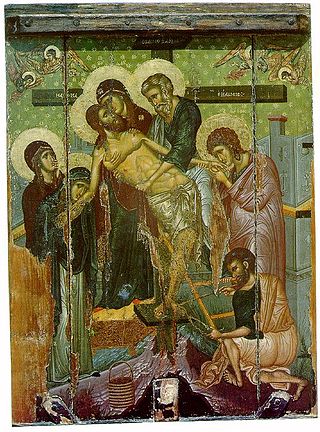
Joseph of Arimathea is a Biblical figure who assumed responsibility for the burial of Jesus after his crucifixion. Three of the four canonical Gospels identify him as a member of the Sanhedrin, while the Gospel of Matthew identifies him as a rich disciple of Jesus. The historical location of Arimathea is uncertain, although it has been identified with several towns. A number of stories about him developed during the Middle Ages.
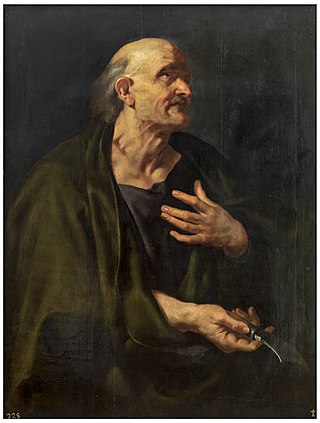
Bartholomew was one of the twelve apostles of Jesus according to the New Testament. Most scholars today identify Bartholomew as Nathanael, who appears in the Gospel of John.

Anthony of Padua, OFM, or Anthony of Lisbon was a Portuguese Catholic priest and member of the Order of Friars Minor.
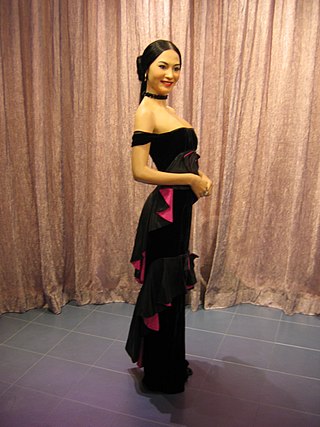
A wax museum or waxworks usually consists of a collection of wax sculptures representing famous people from history and contemporary personalities exhibited in lifelike poses, wearing real clothes.

Longinus is the name given to the unnamed Roman soldier who pierced the side of Jesus with a lance; who in medieval and some modern Christian traditions is described as a convert to Christianity. His name first appeared in the apocryphal Gospel of Nicodemus. The lance is called in Christianity the "Holy Lance" (lancea) and the story is related in the Gospel of John during the Crucifixion. This act is said to have created the last of the Five Holy Wounds of Christ.

In Islam, Jesus is believed to be the penultimate prophet and messenger of God and the Messiah sent to guide the Children of Israel with a book called the Injīl.

Jesus, also referred to as Jesus Christ, Jesus of Nazareth, and many other names and titles, was a first-century Jewish preacher and religious leader. He is the central figure of Christianity, the world's largest religion. Most Christians believe Jesus to be the incarnation of God the Son and the awaited Messiah, or Christ, a descendant from the House of David that is prophesied in the Old Testament.

A novena is an ancient tradition of devotional praying in Christianity, consisting of private or public prayers repeated for nine successive days or weeks. The nine days between the Feast of the Ascension and Pentecost, when the disciples gathered in the upper room and devoted themselves to prayer, is often considered to be the first novena.

Reginald John Campbell was a British Congregationalist and Anglican divine who became a popular preacher while the minister at the City Temple and a leading exponent of 'The New Theology' movement of 1907. His last years were spent as a senior cleric in the Church of England.
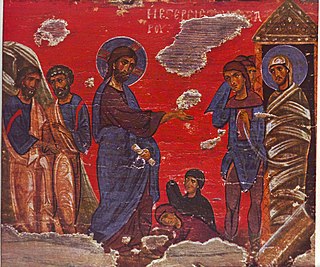
Lazarus of Bethany is a figure within the Christian Bible, mentioned in the New Testament in the Gospel of John, whose life is restored by Jesus four days after his death. This is seen by Christians as one of the miracles of Jesus. In the Eastern Orthodox Church, Lazarus is venerated as Righteous Lazarus, the Four-Days Dead. The Eastern Orthodox and Catholic traditions offer varying accounts of the later events of his life.

The term Poor Man's Bible has come into use in modern times to describe works of art within churches and cathedrals which either individually or collectively have been created to illustrate the teachings of the Bible for a largely illiterate population. These artworks may take the form of carvings, paintings, mosaics or stained-glass windows. In some churches a single artwork, such as a stained-glass window, has the role of Poor Man's Bible, while in others, the entire church is decorated with a complex biblical narrative that unites in a single scheme.
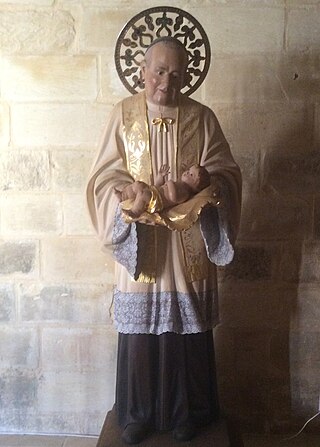
George Franco Preca, T.OCarm was a Maltese Catholic priest, the founder of the Society of Christian Doctrine and a Third Order Carmelite. Pope John Paul II dubbed him "Malta’s second father in faith".
Easter is one of the most significant events in the religious and social calendar, celebrated heavily in the European country of Malta.

Our Lady of Mantara is a Melkite Greek Catholic Marian shrine in Maghdouché, Lebanon, discovered on 8 September 1721 by a young shepherd. The grotto, which according to a legend dates to ancient times, was subsequently cared after by Monsignor Eftemios Saïfi, Melkite Catholic bishop of the Melkite Greek Catholic Archeparchy of Sidon. The shrine consists of a tower crowned with the statue of the Virgin and Child, a cathedral, a cemetery and a sacred cave believed to be the one where the Virgin Mary rested while she waited for Jesus while he was in Tyre and Sidon. Since its discovery, it has been steadily visited by families particularly each year on the occasion of the feast of the Nativity of Mary on 8 September.

The Cross in the Woods is a Catholic shrine located at 7078 M-68 in Indian River, Michigan. It was declared a national shrine by the United States Conference of Catholic Bishops (USCCB) on September 15, 2006. At 55 feet tall, it is the second largest crucifix in the world. The largest Crucifix is in Bardstown, KY, at 60 feet high. The largest Christian cross in the world stands at 492 feet (150m), located in the Valley of the Fallen, Spain.

Christianity has a strong tradition of pilgrimages, both to sites relevant to the New Testament narrative and to sites associated with later saints or miracles.

Nathaniel Hitch (1845–1938) was a British sculptor. As a young man, he became an apprentice sculptor journeyman and after studying at the Borough Polytechnic and experience working alongside architectural sculptors, he developed a career carving altarpieces, church furniture and other decorative features for churches.

Homeless Jesus, also known as Jesus the Homeless, is a bronze sculpture by Timothy Schmalz depicting Jesus as a homeless person, sleeping on a park bench. The original sculpture was installed in 2013 at Regis College, a theological college federated with the University of Toronto. Other copies of the statue were installed in several other locations beginning in 2014. As of 2017, over 50 copies were created and placed around the world.
References
- ↑ "Hundreds gather at Bradford Cathedral for funeral of 'Jesus Man'". The Guardian. Retrieved 13 October 2015.
- ↑ "Bradford Jesus Man' Geoffrey Brindley – 6 years since his death". Telegraph & Argus.
- ↑ "The Jesus Man of Bradford". Church of the Ascension and Saint Agnes. Retrieved 28 April 2022.
- ↑ "Hunting for England's Legendary Bradford Jesus Man". Vice.com. Retrieved 21 August 2015.
- ↑ "Statue for "Jesus Man" of Bradford". Premier Christian News. Retrieved 26 August 2015.
- ↑ "'Bradford Jesus Man' Geoffrey Brindley critically ill after suffering a stroke in stairs fall". thetelegraphandargus.co.uk. Retrieved 2 October 2022.
- ↑ "Search for family of 'Bradford Jesus'". ITV.com. Retrieved 27 August 2015.
- ↑ "Hundreds gather to mourn the loss of Geoffrey Brindley, fondly known as Bradford's Jesus Man". Asian Sunday. Retrieved 19 October 2015.